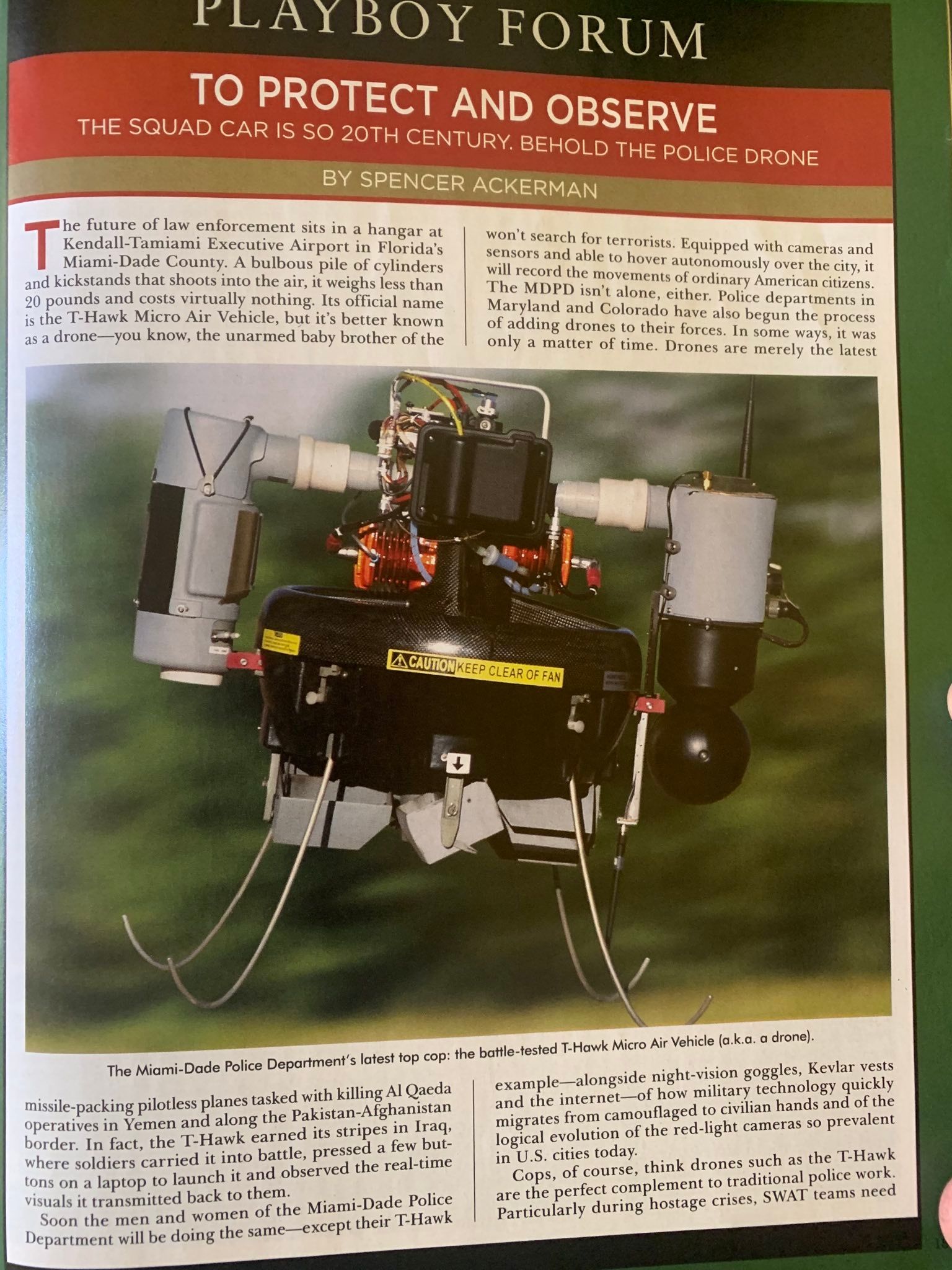Drones Over Brooklyn, RICO for Cop City Protesters
As the Air Force pursues AI-powered drones for combat, the NYPD uses older models to spy on Caribbean Brooklyn. What starts as military tech doesn't stay as military tech. PLUS: Georgia files egregious charges against the anti-Cop City movement!

Edited by Sam Thielman
LABOR DAY IN BROOKLYN IS MORE THAN A DAY OFF (except for the actual working class the holiday is supposed to honor) to barbecue. Eastern Parkway, one of the most majestic of the borough's thoroughfares, hosts the West Indian Day parade, an all-day carnival celebrating the various cultures of the Caribbean. It's a big celebration with a lot of steel drumming that starts with a break-of-dawn party known as J'Ouvert. And because the celebrants are mostly black, it's heavily policed.
This year, it was policed from the air.
Eric Adams, our cop-turned-mayor, let it be known late last week that the NYPD would be sending quad-rotor surveillance drones into the skies owing to anticipated calls concerning "loud music [and] disruptive behavior," two things you can count on during the parade. You can also count on local media to talk about the parade in terms of "violent crime"—violence is not unheard of around the periphery of the parade, unfortunately—and certain locals who may be new to the area love to call the cops on revelers.
Adams described the drones as a "force multiplier" that frees up police resources, rather than a police resource in and of itself. "We have our 311 calls, and they’re complaining about noise. We can deploy the drones to see—it just might be people having a nice orderly party, so we don’t have to deploy so many resources," he said at a Friday press conference. Then he lectured people to ignore "the sci-fi aspects of drones—nobody’s going to be monitored," he said, all while describing a deployment that wouldn't occur in response to crime but ahead of a determination that a crime has even occurred.
As El-P predicted a full decade ago—over one of his all-time best beats, which is saying something—it was drones over Brooklyn. The drones played absolutely no role in preventing someone from getting shot and two others from getting stabbed. All they did was further normalize police surveillance over routine aspects of civic life, like an annual carnival.
It will be very interesting to see what the NYPD inspector general reports about the drone deployment in next year's assessment of compliance with a city law, the POST Act, about transparency over police surveillance. The most recent report determined that the police comply technically but not meaningfully, using "boilerplate language that failed to provide sufficient detail concerning the use or nature of the technology at issue, or to differentiate between technologies."


In 2011, the year before El-P released "Drones Over Bklyn," Playboy asked me to write something about the then-brand-new development of police departments taking custody of drones. I talked with the Miami-Dade police department, which at the time was navigating the uncertain bureaucratic terrain of FAA approval for their T-Hawk Micro Air Vehicle, and they envisioned using it as an adjunct surveillance in high-stakes crises like hostage situations. Foreshadowing Adams, one of their points was that the T-Hawk could only stay aloft for 45 minutes, creating an inherent limit to the amount of privacy damage the drone could perform. (The piece was never online, sorry.)
But routinization evolves just as surely as do technology, markets and permissiveness. That's part of how we go from the Miami police viewing drones as an emergency tool in 2011 to the NYPD putting quad-rotors with cameras over a street party in 2023. The other part concerns "how military technology quickly migrates from camouflaged to civilian hands," as I wrote in Playboy. [DJI, the company that sells the NYPD its drones, also makes drones used by the U.S. military and has a terrible privacy record.—Sam.]
For an ominous glimpse at the next generation of drones that may one day migrate to the skies over Brooklyn, the New York Times recently reported on an experimental Air Force drone known as the Valkyrie. A decade ago, a school of military thought contended that drones were reaching the end of their battlefield relevance. A slow and dumb remote-controlled robot might be useful to kill people in situations where the U.S. enjoyed uncontested aerial superiority. But against a near-peer competitor, equipped with a sophisticated air fleet and anti-aircraft missiles, the argument went, the drones would be scrap metal and the Air Force would be better off investing in its traditional big-ticket manned fighter aircraft.
But that was never going to be how it went with an emergent military technology. The Valkyrie is instead intended to be an AI-driven wingman for fighter pilots in contested airspace—think of a war with China above the Taiwan Strait or elsewhere in the "first island chain"—with the capability to fire on a target perceived as righteous by its sensors, like an air-defense battery. Anyone who's seen that video of Elon Musk needing to stop an autonomous Tesla from running a red light will have doubts about the wisdom of letting AI select targets.
While the Air Force says a human will still have to sign off on a weapons release, the Valkyrie pushes robotic autonomy right to the limit. Since 2012, the Pentagon has said that autonomy can't extend to firing decisions and a human must always be "in the loop" on making that life-or-death judgment. That was an easier call when the state of the technology set more rigid limits on drone autonomy. Advances in AI have compelled the Pentagon to reconsider. In January, it revised its policy to promise only "appropriate levels of human judgment over the use of force." You can almost hear the Eric Adams of 2055 dismissing concerns about NYPD Valkyries as sci-fi hyperbole.
WHEN LAST FOREVER WARS CHECKED IN ON THE ANTI-COP CITY MOVEMENT, authorities in Georgia had arrested and charged the infrastructure of the movement, the Atlanta Solidarity Fund. "If [prosecutors are] allowed to be successful, they could take out grassroots organizing groups across the country," Cat Brooks of Oakland's Anti-Police Terror Project told FOREVER WARS at the time. All that has escalated substantially.
News broke on Tuesday that Georgia Attorney General Chris Carr recently indicted 61 people on RICO charges related to the struggle against constructing the $90 million police training facility known as Cop City. "Some face additional charges of domestic terrorism, arson and money laundering," noted the Atlanta Journal-Constitution, which is owned by a firm whose chief executive held a fundraising drive for Cop City. Several of those hit with the RICO charges were already charged with "domestic terrorism" in Fulton County earlier this year.
The RICO indictment, also filed in Fulton County, draws dubious material connections to establish a conspiracy while treating anarchism as terrorism.
"Preparation" to break the law "includes but is not limited to disguising their face, bringing changes of clothing to blend in after the crime is committed, hiding in crowds, and using technology avoidance devices such as Faraday bags and burner phones." The indictment casts anarchist principles—and not only those of anarchists—like mutual aid and solidarity as pre-crime: "These anarchist ideals and actions undergird the occupation of the forested area that will be the site of the Atlanta Public Training Center," the formal name for Cop City.
There are other disturbing tells within the indictment. It casually refers to the 2020 police execution of Rayshard Brooks as "justified," a head-spinning statement considering that the indictment is filed in the same county where prosecutors in 2020 brought charges against the officers who killed him. (They were dropped last year by a special prosecutor.) Then it describes Defend The Atlanta Forest, the activists who occupy the forested area where the training facility is to be built, "justify[ing] shooting a Georgia State Trooper." But the person the police accused of shooting that trooper, the slain protester Tortuguita whom police shot 57 times, didn't have any gunpowder residue on their hands, according to the DeKalb County medical examiner's office.
Finally, the indictment also cites a Department of Homeland Security classification of the anti-Cop City protesters as domestic violent extremists. FOREVER WARS was the first to report that DHS says no such classification exists.
Many of the actual "overt acts in furtherance of the conspiracy" detailed in the indictment border on the absurd—which, in fairness, speaks to the overbroad-by-design structure of RICO. A whole lot of them involve publishing blog posts containing militant language and messaging, which the prosecutors describe as threats against persons and property involved in developing Cop City. Item 148 charges defendant Geoffrey Parsons as "sign[ing] his name as 'ACAB.' This was an overt act in furtherance of the conspiracy." Item 27 alleges defendant Brooke Courtemanche "received $52.22 in reimbursement from the Network for Strong Communities for forest kitchen food. This was an overt act in furtherance of the conspiracy." Item 99 alleges that defendant Emily Murphy received $11.91 "in reimbursement from the Network for Strong Communities for glue. This was an overt act in furtherance of the conspiracy." Another such overt act, alleged to have taken place in December, involved transferring $935 "for restroom support."
When the prosecutors allege traditional criminal activity, they describe it as something much more threatening. One defendant, Francis Carroll, is charged with attempting to break into a building while possessing a lighter, an "accelerant," spray paint and a hammer. Prosecutors call that "committ[ing] the offense of Domestic Terrorism." Meanwhile, last week, in a different jurisdiction, a federal judge thought it was overbroad to describe someone convicted of breaking into the Capitol to overturn an election as a terrorist.
The anarchist collective CrimethInc noted that while it's hardly certain the prosecution will succeed, the implications of the prosecution are as broad as the indictment on which it rests. "It is ideas that are on trial here," CrimethInc. said in a Tuesday statement. "Anyone who does not desire to live in a totalitarian society should put their weight behind efforts to support the defendants and resist this attempt to set a new precedent for state repression."
Similarly, organizers with the Cop City Vote coalition sent this statement to The Appeal:
“These charges, like the previous repressive prosecutions by the State of Georgia, seek to intimidate protesters, legal observers, and bail funds alike, and send the chilling message that any dissent to Cop City will be punished with the full power and violence of the government,” organizers said in a statement emailed to The Appeal. “The Cop City Vote coalition strongly condemns these anti-democratic charges.”
Remember that the Stop Cop City movement sits at the intersection of resistance to climate devastation and institutionalized racism. As both conditions worsen, we can expect such resistance to intensify. Stopping that intensification is the entire point of the RICO charges. That's why the Georgia prosecutors are going after the support infrastructure of the movement and not just those involved in occupying the forest. And they do so garlanded in the rhetoric of counterterrorism, a testimony to the ongoing, mutating nature of the 9/11 era. I wonder when they'll send their own drones over the homes of those who post bail or file legal briefs on behalf of their comrades.
WALLER VS. WILDSTORM #3 is out on Tuesday, September 12 from DC Comics. Go to your local comic store and pick up a copy! This is my favorite of the whole miniseries so far—the issue where we end the setup and propel the book to a climax, making our fourth-issue finale the aftermath of the events in issue three. Our first two issues were dialogue-heavy, as the book is a spy thriller whose engine is conflicting perspectives. This one is non-stop action. Our artists—penciller/inker Jesús Merino, inker Vincente Cifuentes and color artist Michael Atiyeh—take the wheel. I've been comparing this one to episode nine of a ten-issue HBO drama, the one where everything percolating finally explodes. My comics-expert friend Elana Levin, who had me on their podcast when the series debuted (and we'll probably do a follow-up after issue four), posted on Bluesky: "I have read it. It rules. Jaw on the floor. Audible exclamations." Reader, I want you to have those audible exclamations yourself.
As I do each time an issue drops, I'll write a little commentary for FOREVER WARS about issue 3 next week. For reasons that will be clear when you read the issue, this next one will be about Adeline Kane's husband.

